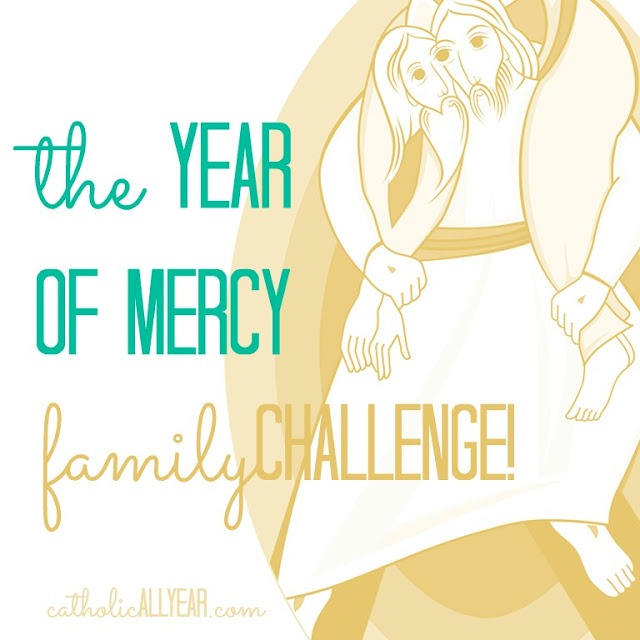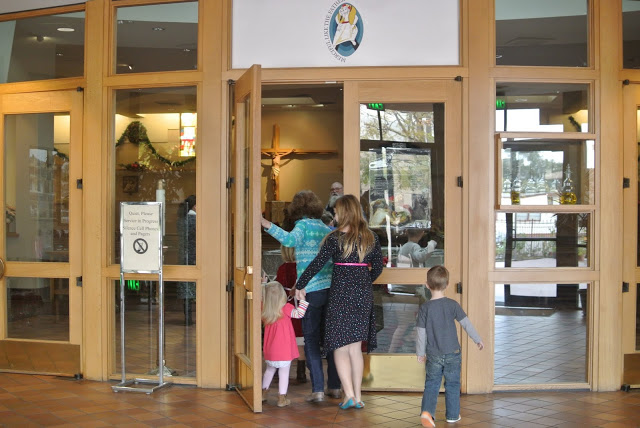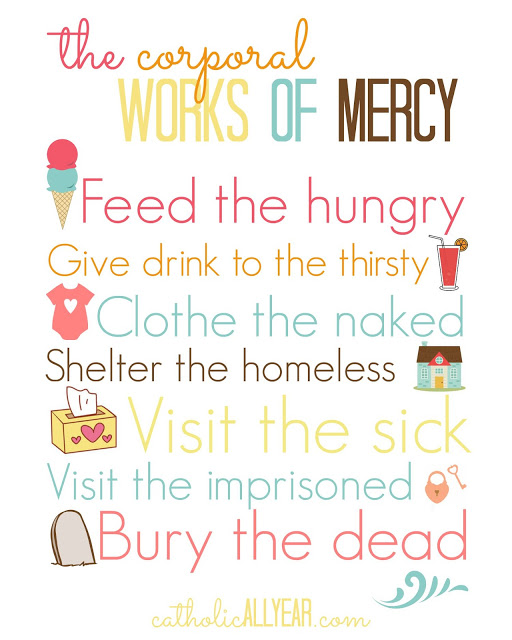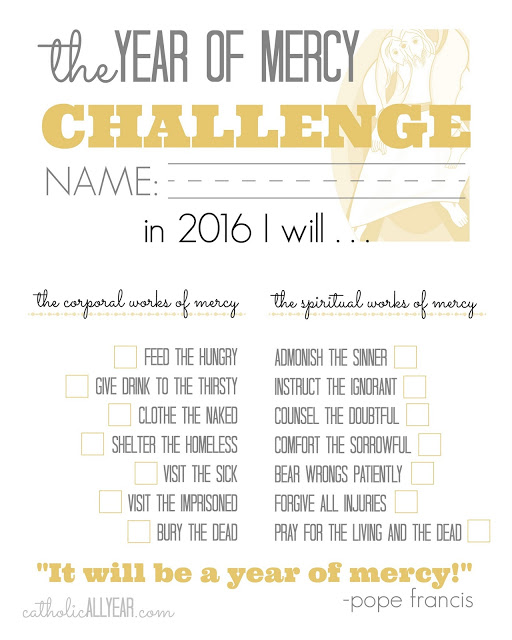It’s the Year of Mercy! But hopefully you already knew that, as I’ve been meaning to write this post since, um, November.
We’ve been making an effort to be mindful of the Year of Mercy in our home, and we came up with a Year of Mercy Family Challenge to go with it. Perhaps you’d like to play along?
- Feed the hungry
- Give drink to the thirsty
- Clothe the naked
- Shelter the homeless
- Visit the sick
- Visit the imprisoned
- Bury the dead
- Admonish the sinner
- Instruct
the ignorant - Counsel the doubtful
- Comfort the sorrowful
- Bear wrongs patiently
- Forgive all injuries
- Pray for the living and the dead
and I plan to participate too. Below you’ll find some ideas for each
of the works of mercy. Some might seem too hard, some might seem too
easy. I’m hoping that there will be a “just right” in there for everyone, but of course, the lists are just a jumping off point. Flexibility is recommended. Some things we will do as a planned family activity, some things the kids will be on the look out for opportunities to do individually.
Much of the following is inspired by The New Saint Joseph Baltimore Catechism (No. 2) I highly recommend it, as well as the First Communion Catechism, and the Pink Catechism No. 1.
The corporal works of mercy are pretty straightforward, but most take some planning and effort. They put our focus on taking care of people physically. This is an important thing to do out of basic Christian charity, of course, but also, the corporal works of mercy set the stage for the spiritual ones. If people’s basic physical needs are not met, they are unlikely to be particularly receptive to being admonished or counseled or even forgiven.
Feed the hungry:
- volunteer at a soup kitchen
- make sandwiches and hand them out to homeless people
- bring a meal to a family with a new baby
- bring a meal to a family having a difficult time
- share food with a friend or sibling
- make dinner for your family
- throw a dinner party for friends you don’t think could afford a nice dinner
- don’t throw a dinner party and donate the money you would have spent
- eat beans and rice for a week and donate your grocery money
Give drink to the thirsty:
- give water to someone working in your neighborhood
- set up a lemonade stand and donate the money you make
- give out water bottles at an event on a hot day
Clothe the naked:
- clean out your closets and donate your unneeded clothing
- organize a charity clothing drive
- offer to help sort clothing at your local pregnancy resource center
- do the laundry for your family
- help a younger sibling get dressed
Visit the imprisoned (people can often feel imprisoned in ways other than being in jail):
- visit an imprisoned friend or family member
- write a letter to an imprisoned friend or family member
- visit an old folks home, or a lonely member of your parish
- offer to babysit for a mother of all young children
- offer to babysit a younger sibling for your mom
Shelter the homeless:
- donate food or blankets to a homeless shelter
- donate to disaster relief services
- take in a foster child
- take in a needy relative
- help an elderly neighbor with home repairs
Visit the sick:
- visit a friend or family member in the hospital
- visit a nursing home
- look after a sick member of your family at home
- help an old or sick person with errands or chores
Bury the dead:
- go to a funeral (yes, even kids)
- visit a cemetery and put flowers on graves
- learn about your ancestors
The spiritual works of mercy require less planning ahead but for that and other reasons, they are trickier to get right. Many of them require a relationship with the person you hope to help. Many require tact. But I think we can do this.
Admonish the sinner:
- set a good example
- remind a sibling or friend of the rules
- offer to bring a friend or family member to confession
- have a calm and loving chat with a person with whom you have a relationship about a particular sinful behavior
Instruct the ignorant:
- teach a catechism class
- share a helpful article or blog post in a friendly way
- lend a good book
- be an RCIA sponsor or a godparent
- help a sibling read a book or play a game or learn a prayer
Counsel the doubtful:
- learn the teachings of the Catholic Church so you’ll have the answer if you get asked a question
- pray outside an abortion clinic
- be there to listen to a friend and give good advice
- reach out to a friend you think might need good advice
- help a sibling or friend make the right choice
Comfort the sorrowful:
- visit a friend or family member who is having a difficult time
- send someone a sympathy card or a care package
- remember the anniversary of a friend’s miscarriage or loss of a child or spouse
- read a story or sing a song to a sibling who is feeling sad
Bear wrongs patiently:
- don’t get mad at other drivers
- assume the best of people you encounter in real life and online
- give up a toy that a friend or sibling wants to play with, even though you had it first
- don’t gossip about the bad behavior of others
- don’t tattle
Forgive all injuries:
- forgive a grudge you’ve been holding, even though it was the other guy’s fault
- call or write to an estranged friend or family member
- give a friend or sibling a second chance
Pray for the living and the dead:
- go through the Holy Doors to gain a plenary indulgence for a deceased love one
- visit a cemetery, especially in November
- keep a list of prayer intentions
- say a family rosary
I made up this free printable, so each member of the family can keep track of each of his works of mercy this year. Some will be pretty easy to check off once, but hopefully kids AND grownups will be inspired this year to practice mercy again and again.
As with all my printables, you are welcome to save the images to your computer for your own personal use. You may print the images and/or upload them and have prints made for your personal use or to give as gifts. First click on the image to bring it up in a new window, then right-click on the image to save it to your computer. You may use my images on your blog, just please link back to my blog. If you would like to sell my images, please contact me first.
For LOTS MORE free printable prayers, check out my Pinterest board.
UPDATE 2024: Grab your free printables at the links below!
Year of Mercy?! Don’t know what I’m talking about? Lemme esplain . . .
The Extraordinary Jubilee of Mercy (Latin: Iubilaeum Extraordinarium Misericordiae) is a Roman Catholic period of prayer held from the Feast of the Immaculate Conception (December 8), 2015 to the Feast of Christ the King (November 20), 2016.
A few details:
Also called Holy Years, jubilees normally occur every 25 years. They feature special celebrations and pilgrimages, calls for conversion and repentance, and the offer of special opportunities to experience God’s grace through the sacraments, especially confession.
Extraordinary holy years, such as the Holy Year of Mercy, are less frequent but offer the same opportunities. The last extraordinary jubilee was called by St. John Paul II in 1983 to mark the 1,950 years after the death of Jesus. John Paul also led the last holy year, known as the “Great Jubilee,” in 2000.
The Year of Mercy called for by Francis is the third “extraordinary” jubilee since the tradition began 700 years ago.
There are Holy Doors involved. THE Holy Door is one particular door in St. Peter’s Basilica:
Pope Francis will open the Holy Door in the basilica. Each of Rome’s major basilicas has its own holy door, which are traditionally sealed from the inside and only opened during jubilee years. The door usually is sealed with bricks as a symbolic reminder of the barrier of sin between human beings and God. Those who pass through a Holy Door during this jubilee year will receive a plenary indulgence, which removes all of the temporal punishment for sins committed up to that time — provided the recipient also goes to confession, receives Communion, and prays for the pope.
Planning a trip to Rome with all the kids? Great! I highly recommend it. (See . . here, when Jack had his First Communion with BXVI and again here, a near miss on the second shot.) Be sure to go through the Holy Door at St. Peter’s. But, if that’s not in the cards for you this year:
On Sunday, Dec. 13, five days after the opening of the jubilee, every diocese around the world is supposed to open a Holy Door. These doors can be in the local cathedral or other churches of particular relevance, such as a Marian shrine.
This will be a historical first, reflecting Pope Francis’ desire that the jubilee be celebrated on the local level and not just in Rome.
Several dioceses have registered their doors at the jubilee’s website, but thousands still have to do so so they will appear on an interactive Google map made for the occasion.
Wondering if there’s a Holy Door at your parish? Check your diocese website, or just look around for the Year of Mercy logo.
Some folks are pretty weirded out by the logo, but I’m a big fan of the mosaics done by this same artist that we saw on our pilgrimage to Italy. So, I’m going to refrain from comment. 🙂
But, wait, there’s more!
Beyond the opening of the four Holy Doors, there will be monthly
events headed by Pope Francis aimed to shine a light on 14 “works of
mercy,” acts that are intended to be both penance and charity.
These works of mercy are divided into “corporal” and “spiritual,” and
they include feeding the hungry, visiting the sick, sheltering the
homeless, instructing the ignorant, and praying for the living and the
dead.
Click here to go through to their page, then click on “shop” on the top menu.
UPDATE 2024: The sale from CCC has ended!
Now, get out there and be merciful!
This post contains affiliate links.











